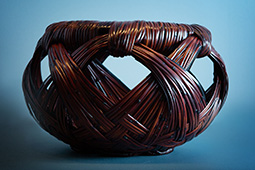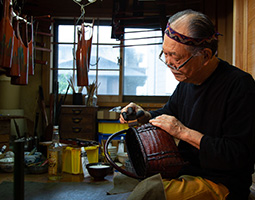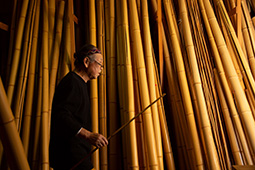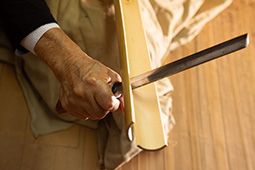August 2022
- English
- 日本語
Bamboo Artist Fujinuma Noboru

A flower basket made using the tabaneami technique by Fujinuma Noboru (48 cm x 26 cm) 
A wicker presentation basket by Fujinuma Noboru (42 cm x 18 cm)

Close-up of the above work showing the novel twist conceived by Fujinuma 
A flower basket by Fujinuma Noboru (72 cm x 46 cm) 
Fujinuma at work on a bamboo basket 
Fujinuma in his workshop with his locally harvested bamboo 
Creating bamboo strands (takehigo) by splitting the bamboo

Fujinuma Noboru creates works of art by skillfully making use of the simplicity of bamboo, and his works are highly esteemed both within Japan and internationally.

Bambooworking is the traditional art of making items from bamboo, typically by weaving split and shaved rodlike bamboo strands (takehigo) to create objects with gentle curves and sharp, straight lines. Bambooworking is used to make a variety of utensils for everyday life such as trays, baskets and bowls, as well as serving ware used in the tea ceremony, vases for flower arrangement and decorative interior design items for modern life. The many items produced through bambooworking are highly esteemed both within Japan and abroad as folk crafts and as art.
Otawara City, Tochigi Prefecture is home to quality bamboo and has produced numerous excellent bamboo artists. Fujinuma Noboru, a leading bamboo artist of modern Japan, was born here in 1945 and has been designated by the Japanese government as a holder of Important Intangible Cultural Property, also known as a Living National Treasure.

Fujinuma started on the path of bambooworking after he went abroad for the first time at age 27. During this trip to Paris, France, he encountered local people valuing and taking pride in their culture of stone, as represented by the Champs-Élysées, the Arc de Triomphe, the Louvre Museum, and other heritage from the Napoleonic era. The idea that Japan also has a wonderful culture swelled up inside Fujinuma, but he didn’t have the means to express it at that time.
After returning to Japan, he began to study traditional Japanese culture and took a variety of traditional art lessons, including calligraphy, woodblock printing, and bambooworking. One day, an employee at a favorite bookstore showed Fujinuma a book. It was a collection of the works of Shono Shounsai (1904–1974), who had been designated as a holder of Important Intangible Cultural Property in 1967.

Fujinuma says, “When I looked at the book, I was shocked at the bambooworking, works of ‘art’ made from bamboo and by human hands. From there, I became an apprentice to a master bamboo artist and began to really study the techniques. I was quite skillful with my hands, so I was able to learn everything in about a year, and since then, I have continued to study on my own while looking at photos from that collection of his works.”
Strong inspiration and motivation are essential for self-study. For Fujinuma, the powerful vitality of bamboo in particular, with its stems that can grow 60 to 70 cm in a day, became the inspiration and motivation to create his works.

Fujinuma creates using five different types of Otawara-grown bamboo, each for a specific purpose. His works are varied, with some that are simple with a delicate and warm feel, some that are supple and elegant, and still some that are full of virile strength. All of these utilize the bamboo material to the fullest.
“One day in 1992, by chance I twisted the bundle of bamboo strands when making something using the traditional tabaneami technique* and noticed the unexpected results. I decided to try and apply this to my work by making this twist a part of my own original technique.”

Since then, Fujinuma has been acutely aware of the strength that characterizes bamboo’s vitality, as well as the delicate nature of the material, and has come to make the parallel expression of these contradictory elements a creative theme in his works.
His works are highly esteemed both in Japan and abroad, with the majority having been exhibited overseas. Fujinuma’s works have been added to the collections of the Metropolitan Museum of Art and the Art Institute of Chicago in the United States, and the British Museum in the United Kingdom.

Having a thorough understanding of the properties of bamboo, Fujinuma creates works of art by carefully selecting wild-growing bamboo in Otawara. These works, made using the traditional material that is bamboo, are well suited to modern living spaces and possess the power to appeal to people around the world.
* A method for creating shapes by bundling and weaving several hundred thin bamboo strands together.

